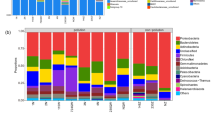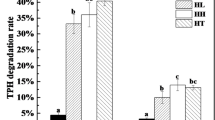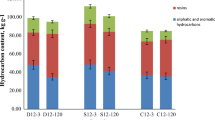Abstract
Microorganisms are the driver of petroleum hydrocarbon degradation in soil micro-ecological systems. However, the distribution characteristics of microbial communities and hydrocarbon degradation dynamics during the remediation of petroleum-contaminated soil by enhancing moisture content are not clear. In this study, polymerase chain reaction and high-throughput sequencing of soil microbial DNA were applied to investigate the compositions of microorganisms and alpha diversity in the oil-polluted soil, and the hydrocarbon removal also being analyzed using ultrasonic extraction and gravimetric method in a laboratory simulated ex-situ experiment. Results showed the distribution of petroleum hydrocarbon degrading microorganisms in the petroleum-contaminated loessal soil mainly was Proteobacteria phylum (96.26%)—Gamma-proteobacteria class (90.03%)—Pseudomonadales order (89.98%)—Pseudomonadaceae family (89.96%)—Pseudomonas sp. (87.22%). After 15% moisture content treatment, Actinobacteria, Proteobacteria, and Firmicutes still were the predominant phyla, but their relative abundances changed greatly. Also Bacillus sp. and Promicromonospora sp. became the predominant genera. Maintaining 15% moisture content increased the relative abundance of Firmicutes phylum and Bacillus sp. As the moisture-treated time increases, the uniformity and the richness of the soil bacterial community were decreased and increased respectively; the relative abundance of Pseudomonas sp. increased. Petroleum hydrocarbon degradation by enhancing soil moisture accorded with the pseudo-first-order reaction kinetic model (correlation coefficient of 0.81; half-life of 56 weeks). The richness of Firmicutes phylum and Bacillus sp. may be a main reason for promoting the removal of 18% petroleum hydrocarbons responded to 15% moisture treatment. Our results provided some beneficial microbiological information of oil-contaminated soil and will promote the exploration of remediation by changing soil moisture content for increasing petroleum hydrocarbon degradation efficiency.




Similar content being viewed by others
References
Cho E, Park M, Hur M, Kang GY, Kim S (2019) Molecular-level investigation of soils contaminated by oil spilled during the Gulf War. J. Hazard. Mater 373:271–277
Gao H, Zhang J, Lai HX, Xue QH (2017) Degradation of asphaltenes by two Pseudomonas aeruginosa strains and their effects on physicochemical properties of crude oil. Int. Biodeterior. Biodegradation 122:12–22
Shahi A, Aydin S, Ince B, Ince O (2016) Reconstruction of bacterial community structure and variation for enhanced petroleum hydrocarbons degradation through biostimulation of oil contaminated soil. Chem. Eng. J 306:60–66
Wang SY, Kuo YC, Hong A, Chang YM, Kao CM (2016) Bioremediation of diesel and lubricant oil-contaminated soils using enhanced landfarming system. Chemosphere 164:558–567
Wu ML, Ye XQ, Chen KL, Li W, Yuan J, Jiang X (2017) Bacterial community shift and hydrocarbon transformation during bioremediation of short-term petroleum-contaminated soil. Environ. Pollut 223:657–664
Xu JL, Zhao MH, Wang R, Du J, Zhang QJ (2019) Efficiently dedicated oxidation of long-chain crude oil in the soil by inactive SOM-Fe. Chem. Eng. J. https://doi.org/10.1016/j.cej.2019.121913
He J, Fan XR, Liu H, He XT, Wang QZ, Liu Y, Wei HF, Wang B (2019) The study on Suaeda heteroptera Kitag, Nereis succinea and bacteria's joint bioremediation of oil-contaminated soil. Microchem. J 147:872–878
Whelan MJ, Coulon F, Hince G, Rayner J, McWatters R, Spedding T, Snape I (2015) Fate and transport of petroleum hydrocarbons in engineered biopiles in polar regions. Chemosphere 131:232–240
Wu ML, Wu JL, Zhang XH, Ye XQ (2019) Effect of bioaugmentation and biostimulation on hydrocarbon degradation and microbial community composition in petroleum-contaminated loessal soil. Chemosphere. https://doi.org/10.1016/j.chemosphere.2019.124456
Roy A, Dutta A, Pal S, Gupta A, Sarkar J, Chatterjee A, Saha A, Sarkar P, Sar P, Kazy SK (2018) Biostimulation and bioaugmentation of native microbial community accelerated bioremediation of oil refinery sludge. Bioresour. Technol 253:22–32
Abed RMM, Al-Kharusi S, Al-Hinai M (2015) Effect of biostimulation, temperature and salinity on respiration activities and bacterial community composition in an oil polluted desert soil. Int. Biodeterior. Biodegrad 98:43–52
Ali H, Mohammad HF, Mahin S (2016) The effect of soil type on the bioremediation of petroleum contaminated soils. J. Environ. Manag 180:197–201
Wu ML, Li W, Warren AD, Ye XQ, Chen LM (2017) Bioremediation of hydrocarbon degradation in a petroleum-contaminated soil and microbial population and activity determination. Chemosphere 169:124–130
Gao H, Zhang J, Lai HX, Xue QH (2017) Degradation of asphaltenes by two Pseudomonas aeruginosa strains and their effects on physicochemical properties of crude oil. Int. Biodeterior. Biodegradation 122:12–22
Xu JL, Zhang QJ, Li DY, Du J, Wang C, Qin JY (2019) Rapid degradation of long-chain crude oil in soil by indigenous bacteria using fermented food waste supernatant. Waste Manag 85:361–373
Whelan MJ, Coulon F, Hince G, Rayner J, McWatters R, Spedding T, Snape I (2015) Fate and transport of petroleum hydrocarbons in engineered biopiles in polar regions. Chemosphere 131:232–240
Trellu C, Mousseta E, Pechaud Y, Huguenot D, Hullebusch EDV, Esposito G, Oturan MA (2016) Removal of hydrophobic organic pollutants from soil washing/flushing solutions: a critical review. J. Hazard. Mater 306:149–174
Onotasamiderhi TI, Paola M, Russell JD, David W (2019) Impacts of activated carbon amendments, added from the start or after five months, on the microbiology and outcomes of crude oil bioremediation in soil. Int. Biodeterior. Biodegradation 142:1–10
Chang W, Dyen M, Spagnuolo L, Simon P, Whyte L, Ghoshal S (2010) Biodegradation of semi- and non-volatile petroleum hydrocarbons in aged, contaminated soils from a sub-arctic site: laboratory pilot-scale experiments at site temperatures. Chemosphere 80:319–326
Gomez F, Sartaj M (2013) Field scale ex-situ bioremediation of petroleum contaminated soil under cold climate conditions. Int. Biodeterior. Biodegradation 85:375–382
Paudyn K, Rutter A, Rowe RK, Poland JS (2008) Remediation of hydrocarbon contaminated soils in the Canadian Arctic by landfarming. Cold Reg. Sci. Technol 53:102–114
Karthick A, Roy B, Chattopadhyay P (2019) A review on the application of chemical surfactant and surfactant foam for remediation of petroleum oil contaminated soil. J. Environ. Manag 243:187–205
Wang SY, Kuo YC, Hong A, Chang YM, Kao CM (2016) Bioremediation of diesel and lubricant oil-contaminated soils using enhanced landfarming system. Chemosphere 164:558–567
Schjønning P, Thomsen IK, Petersen SO, Kristensen K, Christensen BT (2011) Relating soil microbial activity to water content and tillage-induced differences in soil structure. Geoderma 163:256–264
Sigouin MJP, Dyck M, Si BC, Hu W (2016) Monitoring soil water content at a heterogeneous oil sand reclamation site using a cosmic-ray soil moisture probe. J. Hydrol 543:510–522
Zhang HH, Feng J, Chen SN, Zhao ZF, Li BQ, Wang Y (2019) Geographical patterns of nirs gene abundance and nirs-type denitrifying bacterial community associated with activated sludge from different wastewater treatment plants. Microb. Ecol 77:304–316
Meynet P, Hale SE, Davenport RJ, Cornelissen G, Breedveld GD, Werner D (2012) Effect of activated carbon amendment on bacterial community structure and functions in a PAH impacted urban soil. Environ Sci Technol 46:5057–5066
Li XX, Fan FQ, Zhang BY, Zhang KD, Chen B (2018) Biosurfactant enhanced soil bioremediation of petroleum hydrocarbons: design of experiments (DOE) based system optimization and phospholipid fatty acid (PLFA) based microbial community analysis. Int. Biodeterior. Biodegradation 132:216–225
Wu ML, Wu JL, Zhang XH, Ye XQ (2019) Effect of bioaugmentation and biostimulation on hydrocarbon degradation and microbial community composition in petroleum-contaminated loessal soil. Chemosphere. https://doi.org/10.1016/j.chemosphere.2019.124456
Qu YY, Zhang XW, Shen WL, Ma Q, You SN, Pei XF, Li SZ, Ma F, Zhou JT (2016) Illumina MiSeq sequencing reveals long-term impacts of single-walled carbon nanotubes on microbial communities of wastewater treatment systems. Bioresour. Technol 211:209–215
Wu ML, Dick WA, Li W, Wang XC, Yang Q, Wang TT, Xu LM, Zhang MH, Chen LM (2016) Bioaugmentation and biostimulation of hydrocarbon degradation and the microbial community in a petroleum-contaminated soil. Int. Biodeterior. Biodegradation 107:158–164
Hou JY, Liu WX, Wang BB, Wang QL, Franks AE (2015) PGPR enhanced phytoremediation of petroleum contaminated soil and rhizosphere microbial community response. Chemosphere 138:592–598
Vasileva-Tonkova E, Gesheva V (2005) Glycolipids produced by antarctic Nocardioides sp. during growth on n-paraffin. Process Biochem 40:2387–2391
Mohanty G, Mukherji S (2008) Biodegradation rate of diesel range n-alkanes by bacterial cultures exiguobacterium aurantiacum and burkholderia cepacia. Int. Biodeterior. Biodegradation 61:240–250
Zhang DC, Mörtelmaier C, Margesin R (2012) Characterization of the bacterial archaeal diversity in hydrocarbon-contaminated soil. Sci. Total Environ 421–422:184–196
Kim T, Hong JK, Jho EH, Kang GY, Lee SJ (2019) Sequential biowashing-biopile processes for remediation of crude oil contaminated soil in Kuwait. J Hazard Mater:378. https://doi.org/10.1016/j.jhazmat.2019.05.103
Bacosa H, Suto K, Inoue C (2010) Preferential degradation of aromatic hydrocarbons in kerosene by a microbial consortium. Int Biodeterior Biodegr 64:702–710
Das N, Chandran P (2011) Microbial degradation of petroleum hydrocarbon contaminants: an overview. Biotechnol. Res. Int. https://doi.org/10.4061/2011/941810
Ramadass K, Megharaj M, Venkateswarlu K, Naidu R (2018) Bioavailability of weathered hydrocarbons in engine oil-contaminated soil: impact of bioaugmentation mediated by pseudomonas, spp. on bioremediation. Sci. Total Environ 636:968–974
He SY, Ni YQ, Lu L, Chai QW, Yu T, Shen ZhQ Yang CP (2020) Simultaneous degradation of n-hexane and production of biosurfactants by Pseudomonas sp. strain NEE2 isolated from oil-contaminated soils. Chemosphere 242: https://doi.org/10.1016/j.chemosphere.2019.125237
Trellu C, Mousseta E, Pechaud Y, Huguenot D, Hullebusch EDV, Esposito G, Oturan MA (2016) Removal of hydrophobic organic pollutants from soil washing/flushing solutions: a critical review. J. Hazard. Mater 306:149–174
Almansoory AF, Hasan HA, Idris M, Abdullah SRS, Anuar N (2015) Potential application of a biosurfactant in phytoremediation technology for treatment of gasoline-contaminated soil. Ecol. Eng 84:113–120
Santos EVD, Sáez C, Cañizares P, Silva DRD, Rodrigo MA (2017) Treatment of ex-situ soil-washing fluids polluted with petroleum by anodic oxidation, photolysis, sonolysis and combined approaches. Chem. Eng. J 310:581–588
Marie TBA, Li TT, Shah MN, Zhong WH (2019) Biodegradation of total petroleum hydrocarbons (TPH) in highly contaminated soils by natural attenuation and bioaugmentation. Chemosphere 234:864–874
Varjani SJ (2017) Microbial degradation of petroleum hydrocarbons. Bioresour. Technol 223:277–286
Cristina MQ, Ana MTM, Leandro CPL (2019) Overview of bioremediation with technology assessment and emphasis on fungal bioremediation of oil contaminated soils. J. Environ. Manag 241:156–166
Funding
This work was supported by the National Natural Science Foundation of China (No. 21577109), the Program for Innovative Research Team in Shaanxi (PIRT) (Grant No. 2013KCT-13), the Natural Science Foundation of Shaanxi Province (2015JM5163), and the Key Laboratory Project of the Shaanxi Provincial Education Department (13JS048).
Author information
Authors and Affiliations
Corresponding author
Rights and permissions
About this article
Cite this article
Liu, H., Gao, H., Wu, M. et al. Distribution Characteristics of Bacterial Communities and Hydrocarbon Degradation Dynamics During the Remediation of Petroleum-Contaminated Soil by Enhancing Moisture Content. Microb Ecol 80, 202–211 (2020). https://doi.org/10.1007/s00248-019-01476-7
Received:
Accepted:
Published:
Issue Date:
DOI: https://doi.org/10.1007/s00248-019-01476-7




